Skateboarders refuse to see the city as intended. It is a playground. It is theirs. Every curb, bench, and set of stairs is a potential skateable object. Even though I put down my own skateboard around age 15, that mindset stayed with me. Skateboarding gave me a gift: the inclination to resist the pressures that cities feed us to be passive. As I've spent the last decade alongside artists who intervene in public spaces (be that through street art, graffiti, public art, or street performance), that inclination has matured, evolved, and became the driving force behind my work as a writer and curator.
Increasingly, public spaces discourage even simple freedoms: we have parks where the grass is off-limits and subways where musicians are arrested for “disturbing the peace.” Public spaces are enforcing passivity and conformity, not nurturing creativity. I believe that artists, designers, curators, and city planners have a responsibility to reverse that trend. Not for the sake of walking on the grass, but for what comes from people believing that they have a right to walk on the grass and play their guitar on the subway. Let's create spaces that encourage every person to feel a sense of belonging and a right to participate in shaping the public spaces they move through, reasserting those spaces as shared spaces, to borrow from Josh MacPhee.1 Public art, when done right, is one way to do that. It can give people a sense that they belong in the spaces they share, and even a sense that they have a right to design them.
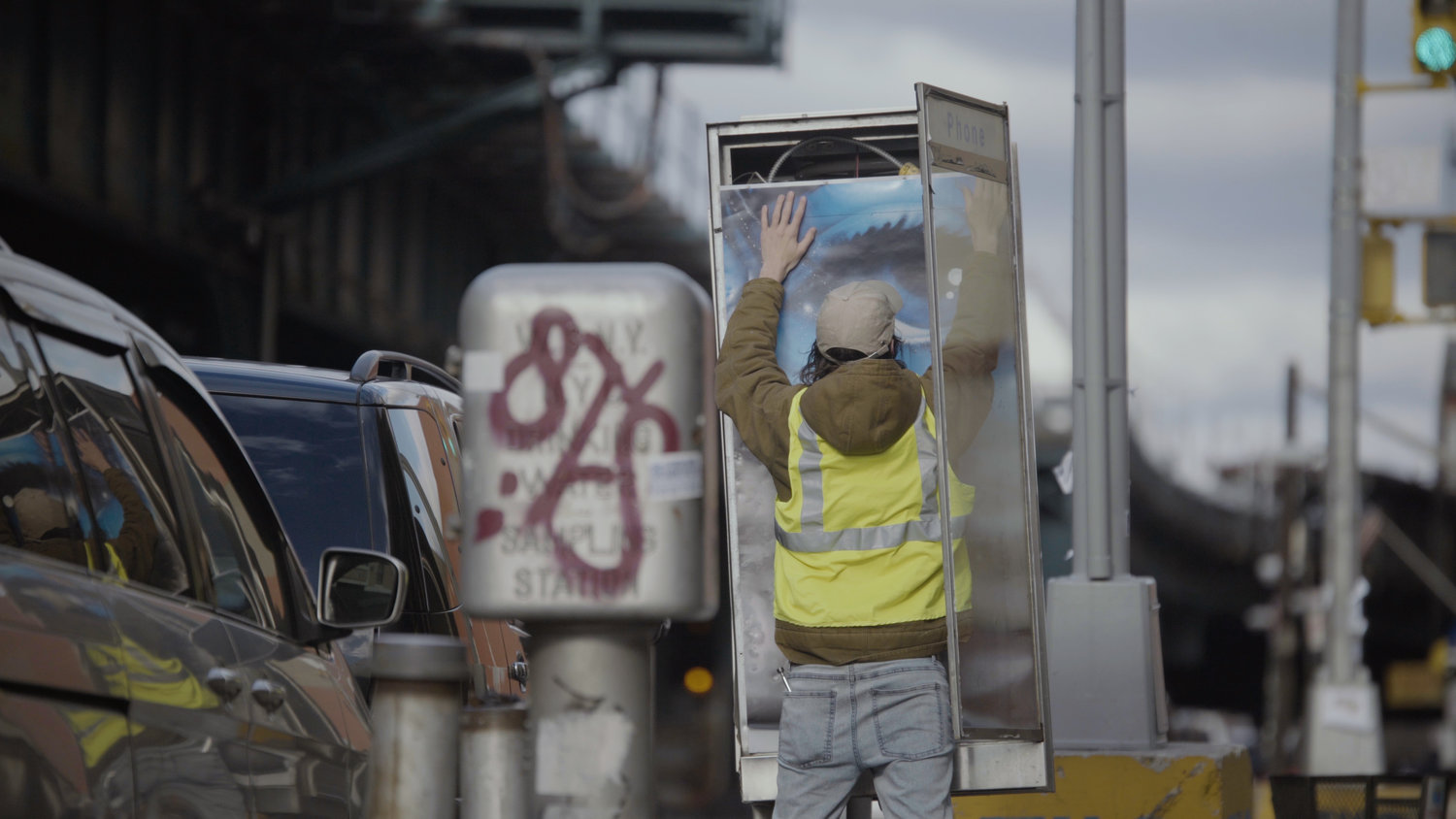
Photo of an Art in Ad Places installation taking place. (Photo by César Martínez Barba)
That's what we are attempting with Art in Ad Places, a public art project that I co-founded alongside artist Caroline Caldwell and photographer Katherine Lorimer (aka Luna Park). In New York City, thousands of payphones are covered in advertisements. Tired of seeing that pollution, three of us decided to start replacing the ads with artwork by our friends. Since launching in 2017, we have installed nearly 100 posters across the city, joining an international community of “ad takeover” artists and activists.

Christine Sun Kim for Art in Ad Places. (Photo by Luna Park)
The basic premise is simple: Partner with artists to install their work in payphones. In 2017, we installed a poster or two by a different artist every week. Since 2018, we have installed about another 40 posters, sometimes partnering with outside curators like Amplifier and Medium Tings. For each poster, Lorimer takes a photo. We share that photo on social media and ask the artist to do the same. We do not hide our names or faces. We talk to the press and we write essays like this one. The documentation and promotion are critical because each poster might only last a few days before it gets discovered and replaced with yet another pointless advertisement. We also ask each artist to contribute a short statement reflecting on why they participated in the project, which we share along with the photos of their poster on the street. We consider the project both guerrilla community service and a marketing campaign against advertising.
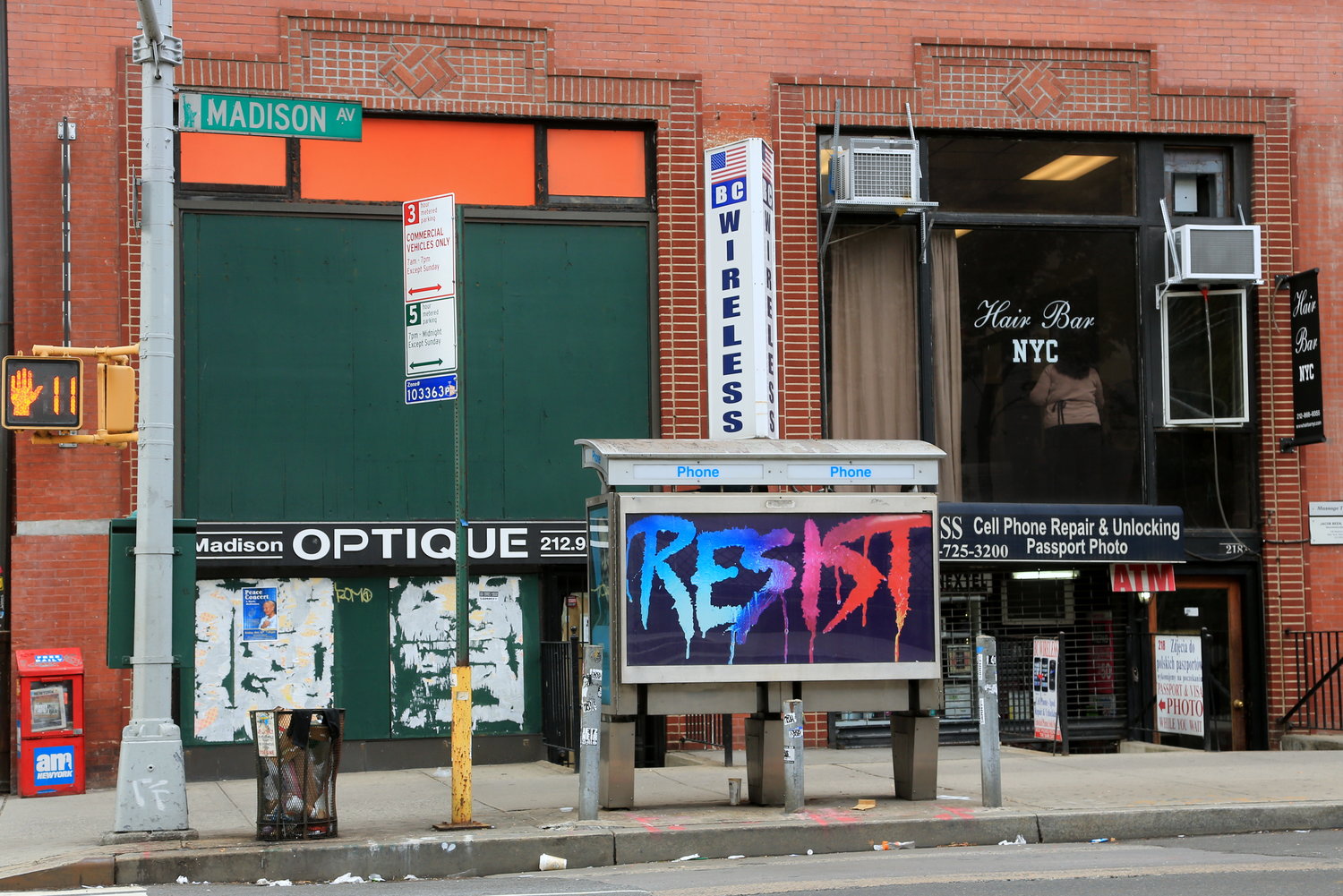
Marilyn Minter for Art in Ad Places. (Photo by Luna Park)
The marketing campaign aspect can rub people the wrong way. We choose to work with artists who have large social media followings. When each print costs nearly $30 and everything is funded out of pocket, it's important to us that we invest in images and artists that we believe are likely to help us reach larger new audiences.
Installing and sharing each individual poster can be rewarding. It certainly feels good to put up images like Marilyn Minter's RESIST, and I truly believe that our public spaces would benefit from more images like Shaniqwa Jarvis' portraits that (in her words) “evoke a sense of beauty, strength, and confidence.” Sadly though, most posters only stay up a brief moment before they are discovered and replaced by new ads. Even when they do last, people have trained themselves to ignore the spaces where they expect to see ads. I fully expect that 99% of the people who pass by our posters don't even register them. And we are under no illusions that one poster in one payphone out of thousands in the city is going to change the world.
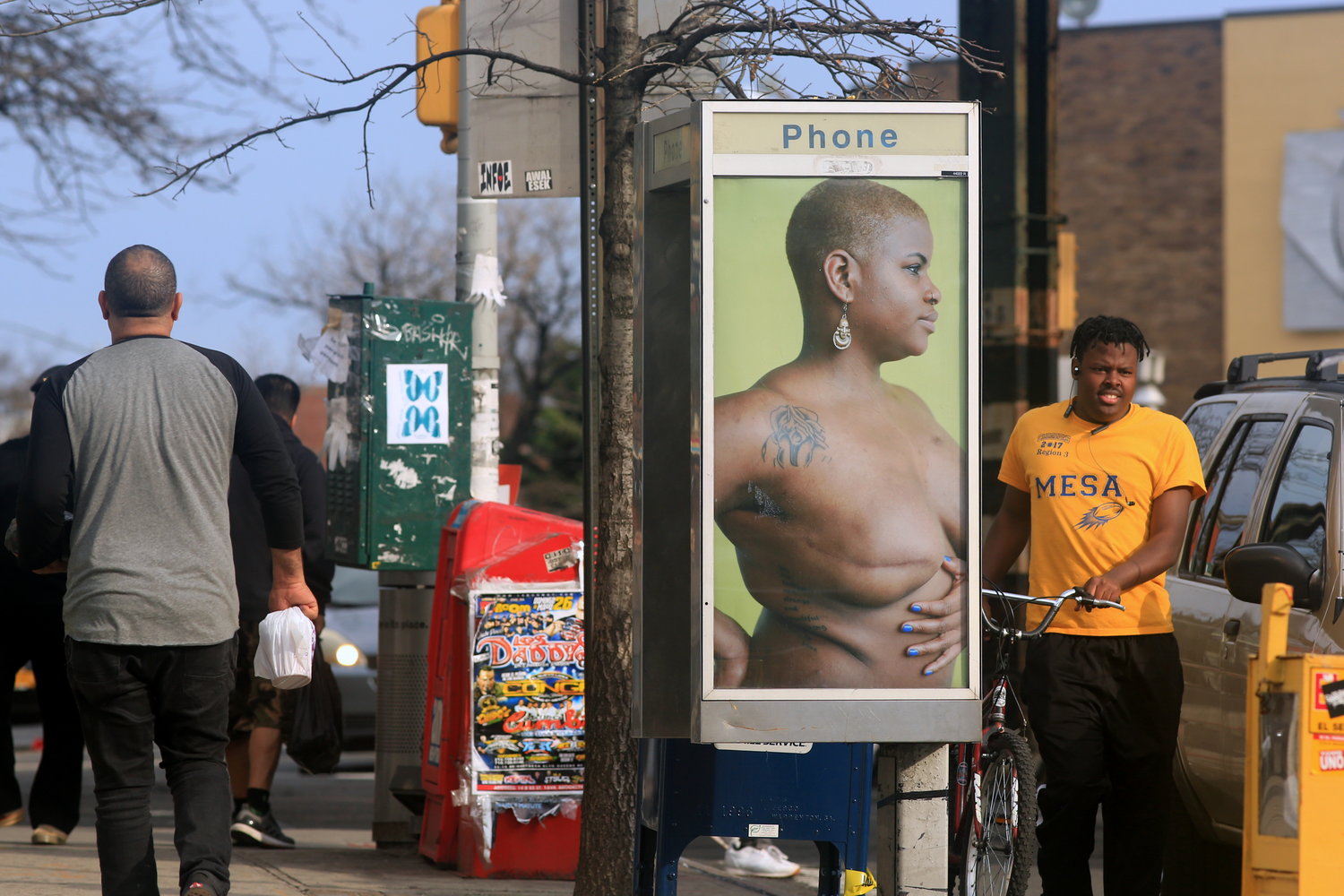
Shaniqwa Jarvis for Art in Ad Places (model: Ericka Hart). (Photo by Luna Park)
In truth, Art in Ad Places is primarily experienced online, through Lorimer's photos. This, I think, is where treating the project like a marketing campaign is worthwhile. Online, each photo is a glimpse into a better future, an alternative vision of shared space where the temporary situation we've created is the norm. We hope that by acting as though we already exist in that future, and by sharing that vision with the widest possible audience, we help to create it. Each installation is both a demand (stop selling us crap in our shared spaces) and a question: what if our shared spaces were filled with this? Or this? Or this? What should we fill these spaces with?

Andrea Sonnenberg for Art in Ad Places. (Photo by Luna Park)
On the goal of fostering a sense of belonging in public space, I think Art in Ad Places is a promising model. Banksy wrote of advertisers that “They leer at you from tall buildings and make you feel small. They make flippant comments from buses that imply you're not sexy enough and that all the fun is happening somewhere else. They are on TV making your girlfriend feel inadequate.”2 We replace that bullying with messages rooted in the affirmation, “you do belong here,” and (crucially) we do not ask anything in return (unlike, for example, Dove’s Real Beauty campaign).3 At least on a superficial level, Art in Ad Places improves public space and fosters a sense of belonging. And when thinking about what public space looks like, the superficial can be essential.

Jamel Shabazz for Art in Ad Places. (Photo by Luna Park)
Taking a wider view, we hope that the project lets other people know that they have the option to improve public space, to share that space. Who am I to say that payphones should be covered in anti-Trump slogans or portraits of breast cancer survivors? We select works that we believe should be in public space, and often because they counterbalance the kinds of images common in advertising. Still, the work we select just reflects the opinions of the Art in Ad Places team, and who are we to dictate anything? Maybe you think they should be covered in paintings of flowers. That's great too. You should feel free to put those posters up.
That, however, is where Art in Ad Places sometimes falls short. Most of us are still trained to assume that a poster in a bus shelter or a pay phone must be trying to sell you something. Artists ask how much it costs to buy an ad in a payphone. We see earnest comments on Instagram along the lines of, “Love this ad. What is it for?” Advertising firms reach out to tell us that they would love to get involved. Even our project’s name falls for this trap, as Hank Willis Thomas points out in the statement accompanying his contribution to the campaign: “I participated in Art in Ad Places because ads are in art places.”4 Touché.
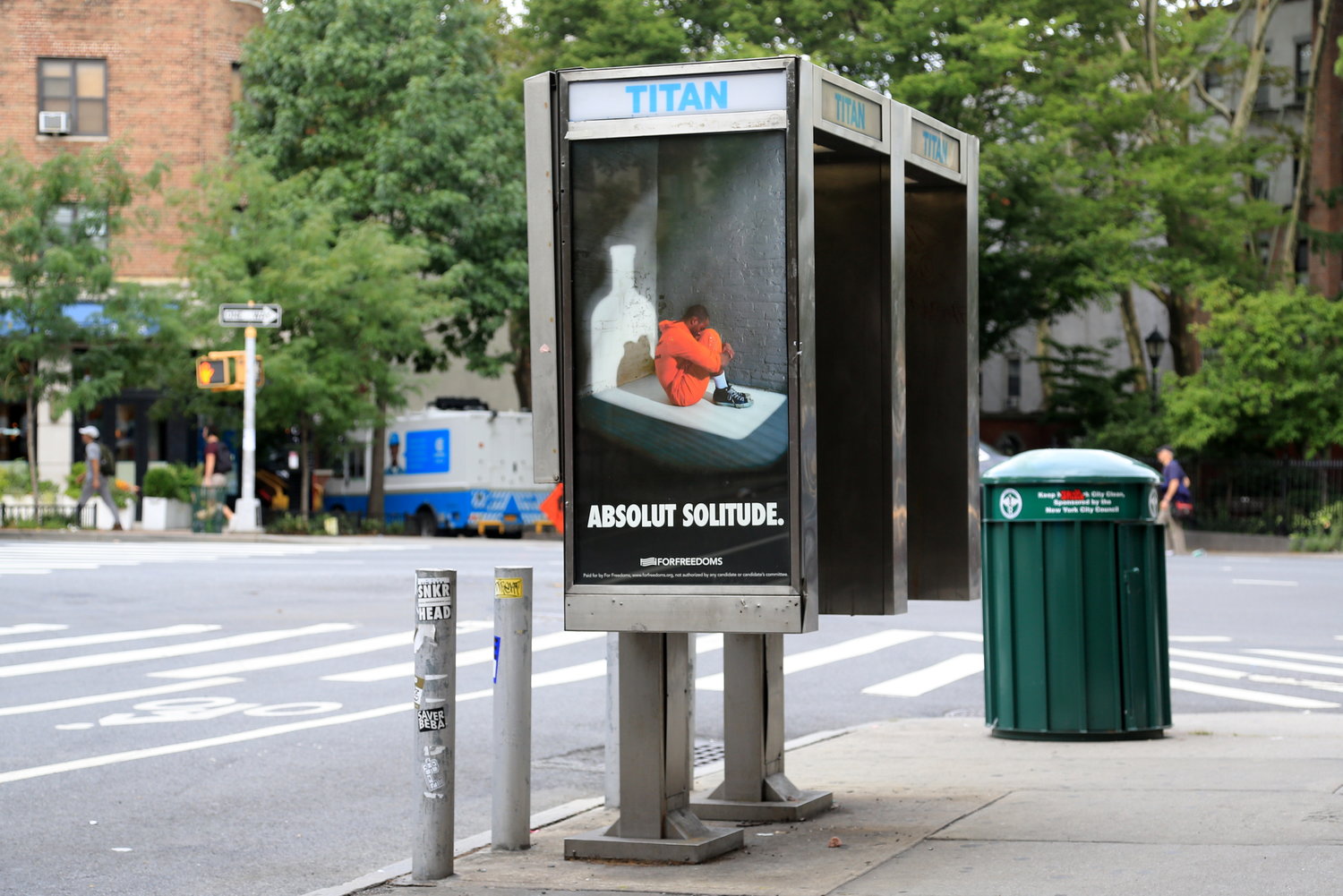
For Freedoms with Hank Willis Thomas for Art in Ad Places. (Photo by Luna Park)
Perhaps most disappointing of all though is what happens when artists who reach out looking to contribute their own work to the project. Most of the time, we say no, for one reason or another. But we always tell those artists that all they need in order to do this sort of thing on their own is a $10 screwdriver from any hardware store. The activist Jordan Seiler, an inspiration and sometimes collaborator, even makes custom “keys” that anyone can purchase to open up bus shelters around the world.5 We share a link to Jordan's website. But then... the artists rarely reply, and we never see them put up their own work. I wonder why. Are they just looking for a quick promotional opportunity? Are they afraid/unable to take the risks that we take (no doubt, as a white man, I face a significantly lower risk of harm from the justice system than other people might)? Are they inspired to imagine the better world that we propose, but not inspired enough to take action?
There’s a critical difference between skateboarding and scrolling through Art in Ad Places’ posts on Instagram: action. Skateboarding is active, and skateboarders learn to see the city differently through active play. Observing Art in Ad Places’ marketing campaign seems to only point towards that mindset, rather than create it. Cristina Lina and Andrew Gillman’s Rope Swings project makes that next step, as Lina recently wrote in DOPE Magazine, by encouraging members of the general public to break the rules and swing on their “unsanctioned rope swings in public spaces.”6
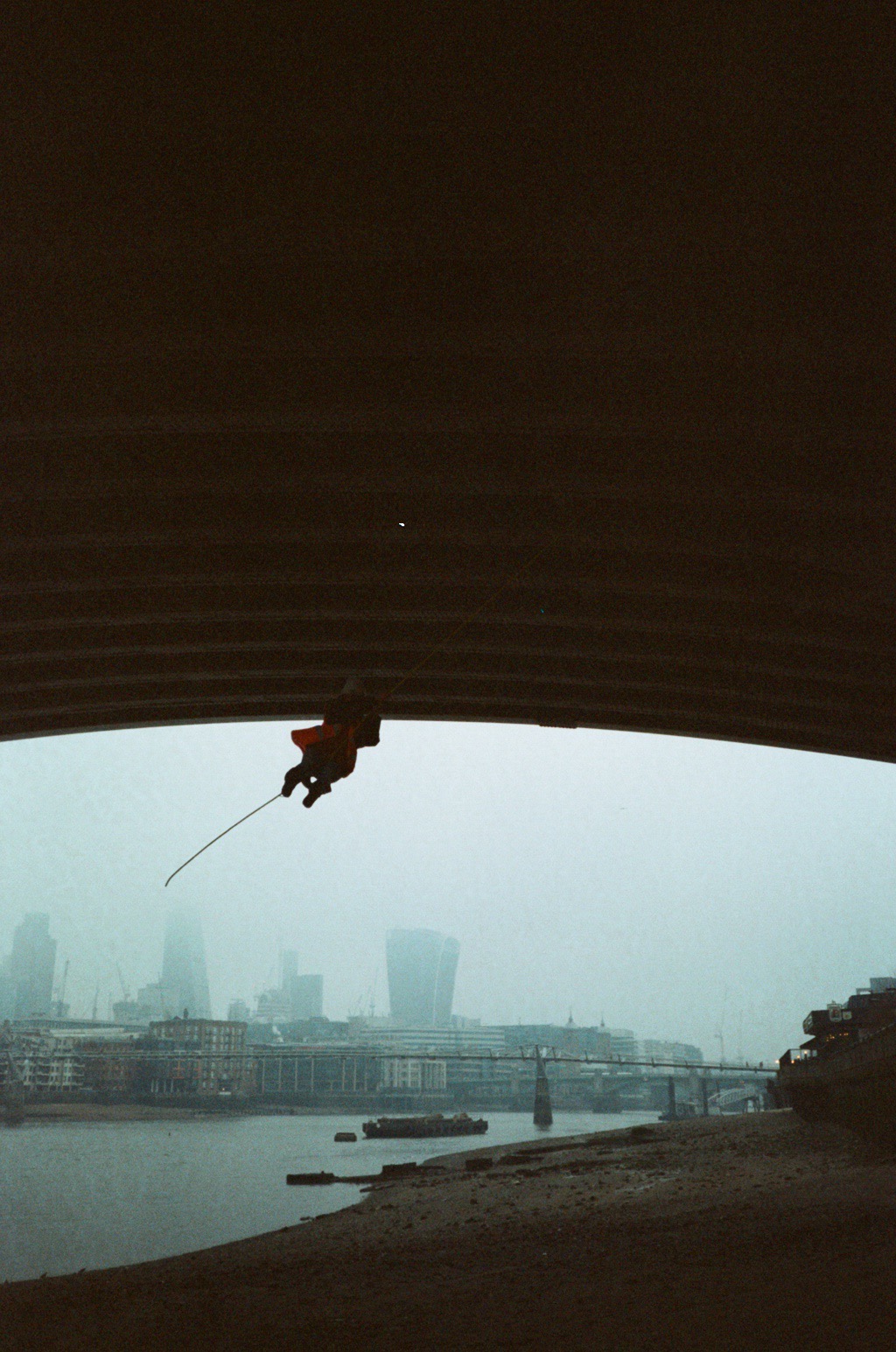
TK rope swing. (Credits Cristina Lina / Andrew Gillman)
We dream of a world where everyone has that special screwdriver, one where installing your own poster in a payphone or bus shelter is no different than pinning a flyer to the bulletin board at the local library. Where unsanctioned rope swings turn busy intersections into sites of play. We hope that Art in Ad Places hints at a possible future where everyone has the right to affect their shared spaces.
Why is this work important, beyond maybe enjoying some of the posters that Art in Ad Places installs? Why is that final leap, to individuals installing their own work in public space, so essential? In a word: opportunity.
Generally, urban public spaces project the idea that people do not even have the right to make a difference. If you live your life in spaces that constantly tell you what you cannot do, you might not do anything.
Shared spaces, which encourage public participation and create a sense of belonging, nudge people towards believing that they can make a difference. If someone believes they can make a difference, they might try. If we want to encourage improved well-being throughout society, we need shared spaces grounded in the principle that every member of the public has the right to exist in them and improve them. I fear that in my own work, I have only gotten halfway there, but I hope that Art in Ad Places is one component of a move towards a future full of shared spaces and active citizens. As for next steps, how about giving everyone on the planet a skateboard?
Art in Ad Places
Twitter @vandalog
Instagram @artinadplaces
Facebook for Art in Ad Places Facebook.com/artinadplaces
Website https://www.artinadplaces.com
